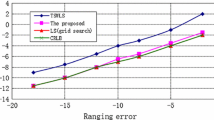Abstract
Linear estimators, including the well-adopted linear least squares (LLS) estimator, have been extensively utilized for wireless location estimation for their simplicity and closed-form property. However, there exists information lost from the linearization of the location estimator to the nonlinear location estimation, which prevents the linear estimator from approaching the Cramer-Rao lower bound (CRLB). In this paper, the linearized location estimation problem based CRLB (L-CRLB) is derived to provide a portrayal in order to fully characterize the behavior of the linearized location estimator. The relationships between the L-CRLB and the CRLB are obtained and theoretically proven in this paper. Furthermore, the geometric layout between the mobile station (MS) and the base stations (BSs) that can achieve the minimum L-CRLB is also acquired. As can be suggested by the L-CRLB, an LLS location estimator can achieve higher accuracy if the MS is located inside the geometry confined by the BSs compared to the case that the MS is situated outside of the geometric layout. This result will be beneficial to the deployment of BSs or the signal selection schemes targeting for location estimation. Simulation results utilizing the LLS estimator as one of the implementation of the linearized location estimators further validate the theoretical proofs and the effectiveness of the L-CRLB.







Similar content being viewed by others
References
Enhanced 911–Wireless Services. Federal Communication Commission. [Online]. Available: http://www.fcc.gov/pshs/services/911-services (visit on Feb. 2010).
Patwari, N., Ash, J. N., Kyperountas, S., Hero, III A. O., Moses, R. L., & Correal, N. S. (2005). Locating the nodes: Cooperative localization in wireless sensor networks. IEEE Signal Processing Magazine, 22, 54–69.
Gezici, S., Tian, Z., Giannakis, G. B., Kobayashi, H., Molisch, A. F., Poor, H. V. et al. (2005). Localization via Ultra-wideband radios: A look at positioning aspects for future sensor networks. IEEE Signal Processing Magazine, 22, 70–84.
Hara, S., Zhao, D., Yanagihara, K., Taketsugu, J., Fukui, K., Fukunaga, S. et al. (2005). Propagation characteristics of IEEE 802.15.4 radio signal and their application for location estimation. In IEEE Vehicular Technology Conference, pp. 97–101.
Feng, S., & Law, C. L. (2002) Assisted GPS and Its Impact on Navigation in Intelligent Transportation Systems. In: IEEE Intelligent Transportation Systems, 926–931.
Farradyne, P. (2005). Vehicle infrastructure integration (VII)—architecture and functional requirements, draft version 1.0 ed.
Perusco, L., & Michael, K. (2007). Control, trust, privacy, and security: Evaluating location-based services. IEEE Technology and Society Magazine, 26, 4–16.
Zhao, Y. (2002). Standardization of mobile phone positioning for 3G systems. IEEE Communications Magazine, 40, 108–116.
Sayed, A. H., Tarighat, A., Khajehnouri, N. (2005). Network-based wireless location: Challenges faced in developing techniques for accurate wireless location information. IEEE Signal Processing Magazine, 22, 25–40.
Foy, W. H. (1976). Position-location solutions by Taylor-series estimation. IEEE Transactions on Aerospace and Electronic Systems, 12, 187–194.
Bahl, P., & Padmanabhan, V. N. (2000). RADAR: An in-building RF-based user location and tracking system. In IEEE INFOCOM, pp. 775 –784.
Caffery, Jr. J. J. (2000). A new approach to the geometry of TOA location. In IEEE Proceedings of vehicular technology Conference, pp. 1943–1949.
Priyantha, N. B. (2005). The cricket indoor location system. Ph.D. dissertation, Massachusetts Institute of Technology.
Cheung, K. W., So, H. C., Ma, W. K., & Chan, Y. T. (2004). Least squares algorithms for time-of-arrival-based mobile location. IEEE Transactions on Signal Processing, 52, 1121–1128.
Wei, H.-W., Wan, Q., Chen, Z.-X., & Ye, S.-F. (2008). A novel weighted multidimensional scaling analysis for time-of-arrival-based mobile location. IEEE Transactions on Signal Processing, 56, 3018–3022.
Yu, K. (2007). 3-D localization error analysis in wireless networks. IEEE Transactions on Wireless Communications, 6, 3473–3481.
Tseng, P.-H., & Feng, K.-T. (2009). Hybrid Network/satellite-based location estimation and tracking systems for wireless networks. IEEE Transactions on Vehicular Technology, 58(9), 5174–5189.
Chaffee, J., & Abel, J. (1994). GDOP and the Cramer-Rao bound. In IEEE position location and navigation system (PLANS) conference, pp. 663–668.
Chang, C., & Sahai, A. (2004). Estimation bounds for localization. In: IEEE Sensor and Ad Hoc Communications and Networks (SECON), pp. 415–424.
Kay, Steven M. (1993). Fundamentals of statistical signal processing: Estimation theory. USA: Prentice Hall.
Acknowledgments
This work was in part funded by the Aiming for the Top University and Elite Research Center Development Plan, NSC 99-2628-E-009-005, the MediaTek research center at National Chiao Tung University, and the Telecommunication Laboratories at Chunghwa Telecom Co. Ltd, Taiwan.
Author information
Authors and Affiliations
Corresponding author
Rights and permissions
About this article
Cite this article
Tseng, PH., Feng, KT. Derivation of CRLB for linear least square estimator in wireless location systems. Wireless Netw 18, 735–747 (2012). https://doi.org/10.1007/s11276-012-0429-0
Published:
Issue Date:
DOI: https://doi.org/10.1007/s11276-012-0429-0




